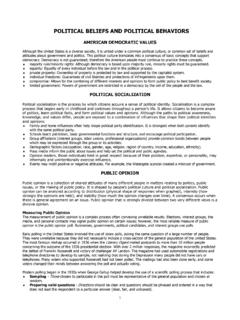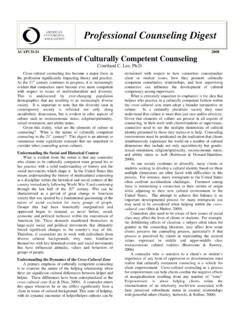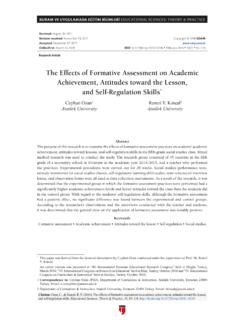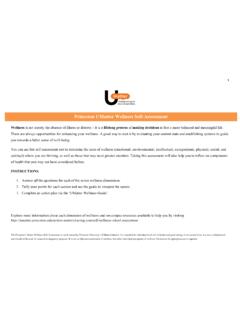Transcription of Students’ Attitudes Towards Learning, A Study on Their ...
1 World Journal of Education Vol. 9, No. 4; 2019 Published by Sciedu Press 109 ISSN 1925-0746 E-ISSN 1925-0754 Students Attitudes Towards Learning, A Study on Their Academic Achievement and Internet Addiction Meral, Sert A r1,* 1 Education Sciences Department, Ataturk Education Faculty, Marmara University, Istanbul, Turkey *Correspondence: Education Sciences Department, Ataturk Education Faculty, Marmara University, Istanbul, Turkey.
2 E-mail: Received: July 24, 2019 Accepted: August 22, 2019 Online Published: August 25, 2019 URL: Abstract Examining Attitudes of students Towards learning, Their academic achievements and internet addictions is the main focus of this Study . With the institution permission obtained from the Provincial Directorate of National Education of stanbul Governorship dated: and No: , a descriptive Study in relational screening model was conducted. By evaluating the data of 355 students (158 male and 176 female), from 370 students studying in the 9th, 10th, and 11th grades attending public high schools in the region of Kad k y, stanbul during 2015-2016 academic year the outcome results were obtained.
3 "Personal Information Form", " Attitudes Towards Learning" and Computer Addiction for Adolescents scales were used in order to collect research data. By analyzing the data with t test, one-way variance analysis (ANOVA) and correlation statistical research techniques in the SPSS program, findings were obtained. A significance level of was taken as the basis in the applied statistics. As per the findings, a difference was found in terms of internet addiction according to gender, academic achievement, homework habits, family activity frequency variables.
4 Furthermore, a negative relationship was found according to the correlation analysis result between students' Attitudes Towards learning and internet addiction. In conclusion, in the light of the the research findings, it is possible to express that differentiation of students' Attitudes Towards learning can support effective and efficient use of information technologies. However, the negative differentiation of the Attitudes Towards learning can generate Internet addiction as a result of inefficient use of the information technologies. Kewords: Attitudes Towards learning, internet addiction, academic achievement 1.
5 Introduction Technology is the product of the reflection of learning competence, which is one of the basic characteristics of human beings, on the problem solving process. Technology, which has gradually transformed human beings into an information society, and perhaps will transform them into a society beyond Their current imaginations, has become the precursors of change and development with its equivalent in the information society. Therefore, rapidly generation and dissemination of information necessitated the differentiation of the human model that the societies needed.
6 It is necessary for this new human being to be aware of what information is meaningful to him in order to define his needs and produce behaviour change in this direction and to be self-directed to achieve his goals. Although this understanding may seem familiar to us as a phenomenon that has brought humanity to these days, the basic tool that drives the information society, considering the speed of development of information technologies and the area of influence, it is obvious that the education understanding that will support the new human model should be very different (Isman & Gungoren, 2013).
7 In other words, the definition and meaning of learning has changed in the information society. In the last decade, especially in an era of rapid development of mobile communication technologies and devices, the characteristics of the people required by the societies have evolved; in order to adapt to the rapidly changing and developing world, communities require individuals who know how to access knowledge, who can use Their knowledge when necessary and who are able to produce new information. Therefore, countries are more careful about Their education systems and make investments accordingly (Scardamalia & Bereiter, 1994; Castells, 1997; Akola , 2004; Atasoy, 2007; Van Merri nboer & Brand-Gruwel, 2005; Stalder, 2006; Buabeng-Andoh, 2012).
8 In the World Journal of Education Vol. 9, No. 4; 2019 Published by Sciedu Press 110 ISSN 1925-0746 E-ISSN 1925-0754 information society, the definition of learning and its meaning for an individual has changed (Castells, 2011). According to Alvin Toffler's statement, "The illiterate of the future will not be the uneducated one. It will be the one who does not know how to learn" (Toffler, 1981). In this context, the main aim of student-centered teaching activities focuses not on "what to teach but rather to teach how to learn".
9 In regard to supporting this process, the relevant literature highlights that without integrating rapidly evolving information technologies into the teaching process, efforts for regulating educational contents, educational activities and educational settings may be incomplete and inadequate (A r, 2007; Duit & Treagust, 2003; Kocac k, 2003; Reis, 2007; Castells, 2013). Teaching supported by information technologies is very different to traditional education (A r, 2014; Drennan, Kennedy, & Pisarski, 2005; Y lmaz & Horzum, 2005; Deperlio lu & K se, 2010, Wu, 2013).
10 The most striking difference is that the instructor and the learner in other words the teacher and the student continuously bears the title the learner (Kettanurak, Ramamurthy, & Haseman, 2001; Sefero lu, 2004). As the traditional role of the teacher in the class disappears, teaching strategies, methods and techniques that will ensure the participation of all students in the classroom with different qualifications and interests can be easily applied (A r & Bayraktar, 2011; Hong, Ridzuan, & Kuek, 2003). Moreover, it is noted that it facilitates access to rich and diverse sources of information, enables the mental energy to be actively used in the most proper way possible as a result of feeling less physical fatigue for the teacher and the students (Baltac & Akp nar, 2011; Rahimi & Yadollahi, 2011).















